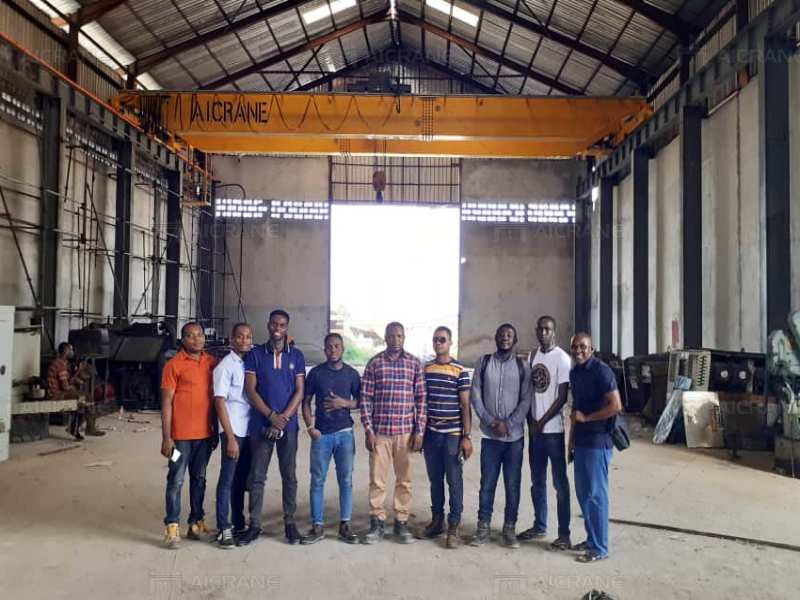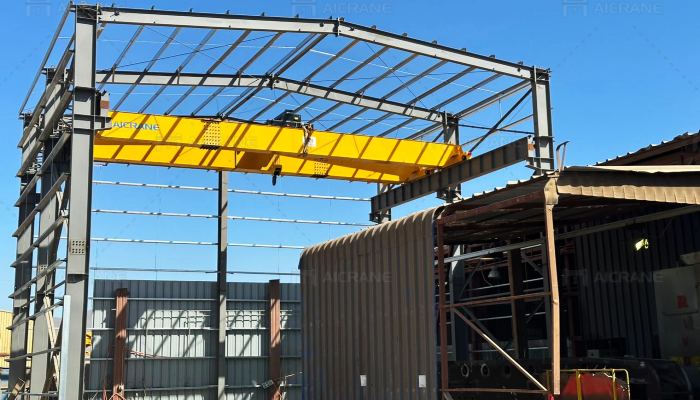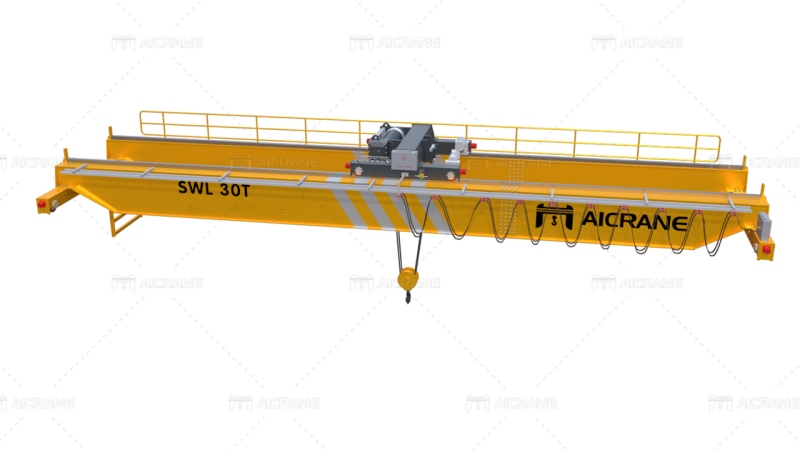6
0
0
How to Train Your Staff for Safe and Efficient 30-Ton Bridge Crane Operation
8
0
Operating a 30 ton bridge crane safely and efficiently requires thorough training and adherence to safety protocols. A 30 ton crane has immense lifting power, so without proper knowledge and respect for safety, it can pose significant risks to both personnel and equipment. Here's a step-by-step guide on how to train your staff for safe and efficient 30 ton bridge crane operation.

Understand the Crane and Its Capabilities
Training should begin with an in-depth understanding of the bridge crane's specifications, capabilities, and limitations. Discuss the crane's design, including its single or double girder configuration, hoisting mechanics, and control system. Highlight key aspects like load capacity (30 tons in this case), lifting height, speed settings, and the maximum load radius. This ensures operators know the crane's exact limitations and can avoid actions that could lead to overloading or equipment damage.
Key Topics to Cover:
Conduct hands-on operational training
Theory alone is not enough for mastering bridge crane operations. Operators should undergo hands-on training to become familiar with crane controls, movement, and handling loads. Set up realistic scenarios where trainees practice moving loads within the crane's operational area. Instruct them to take time adjusting to the controls, as the response time and load movements can vary with different crane models and sizes.
Hands-On Training Components:
Teach Load Calculation and Weight Distribution
Misjudging the weight or improperly distributing a load is a major risk factor in crane operation. Teach operators how to accurately assess the weight of the load, calculate its center of gravity, and ensure it is balanced and secure before lifting. This knowledge will prevent accidents, improve stability, and protect both operators and equipment.
Important Concepts:

Stress the Importance of Pre-Operational Inspections
Pre-operational inspections are a vital part of bridge overhead crane safety. Before every shift, operators should inspect the crane and its components, including the hoist, hooks, ropes, and electrical connections. This helps identify any wear and tear, misalignment, or mechanical issues that could compromise safety.
Checklist for Pre-Operational Inspection:
Focus on Safety Protocols and Emergency Procedures
Safety protocols are critical in preventing accidents, especially when handling a 30 ton load. Operators should be trained to follow all safety rules, maintain a safe distance from the load, and communicate effectively with team members during operations. Additionally, they should know emergency procedures for situations like equipment failure, power outages, or accidents.
Safety Protocols:
Implement Rigging Training
Rigging is an essential skill for crane operators to safely attach and balance loads. Rigging training should cover various lifting devices, such as slings, hooks, and shackles, and how to select and use them correctly based on the load type. Proper rigging practices reduce the risk of load shifting, which can cause the crane to become unbalanced.
Rigging Training Focus:

Conduct Regular Skill Assessments and Refresher Training
Bridge crane operation requires regular skill assessments to ensure operators stay competent and up-to-date on safety protocols. Assessments can identify knowledge gaps or bad habits that may have developed over time. Regular refresher training should reinforce the importance of these protocols and allow operators to practice skills under supervision.
Assessment and Refresher Training Strategies:
Encourage a Safety-First Culture
A safety-first culture ensures that all crane operators feel responsible for safety, not just their own but also their co-workers. Encourage open communication about safety concerns, and promote the reporting of any unsafe conditions. Reinforce the importance of never taking shortcuts, even if it slows down production temporarily.
Building a Safety Culture:
Conclusion
Training staff to operate a 30 ton bridge crane safely and efficiently is crucial for maintaining workplace safety and maximizing productivity. By covering all essential areas—from understanding equipment to mastering rigging and following safety protocols—you'll empower your operators to handle heavy loads with confidence and caution. Regular assessments and a strong safety culture will further reinforce these skills, making the operation of your 30 ton bridge crane a smooth and secure process for everyone involved.

Understand the Crane and Its Capabilities
Training should begin with an in-depth understanding of the bridge crane's specifications, capabilities, and limitations. Discuss the crane's design, including its single or double girder configuration, hoisting mechanics, and control system. Highlight key aspects like load capacity (30 tons in this case), lifting height, speed settings, and the maximum load radius. This ensures operators know the crane's exact limitations and can avoid actions that could lead to overloading or equipment damage.
Key Topics to Cover:
- Maximum load capacity (30 tons) and what that means for safe lifting.
- Basic understanding of hoisting and trolley mechanisms.
- Limit switches, emergency stop functions, and control panel operations.
Conduct hands-on operational training
Theory alone is not enough for mastering bridge crane operations. Operators should undergo hands-on training to become familiar with crane controls, movement, and handling loads. Set up realistic scenarios where trainees practice moving loads within the crane's operational area. Instruct them to take time adjusting to the controls, as the response time and load movements can vary with different crane models and sizes.
Hands-On Training Components:
- Engaging with crane controls, including forward, backward, and side-to-side movement.
- Practicing precise load lifting and placement.
- Navigating challenges such as swinging loads or moving loads across obstacles.
- Emphasizing slow, controlled movements to avoid sudden load shifts or oscillations.
Teach Load Calculation and Weight Distribution
Misjudging the weight or improperly distributing a load is a major risk factor in crane operation. Teach operators how to accurately assess the weight of the load, calculate its center of gravity, and ensure it is balanced and secure before lifting. This knowledge will prevent accidents, improve stability, and protect both operators and equipment.
Important Concepts:
- Assessing load weight and verifying it is within crane limits.
- Understanding center of gravity for safe lifting.
- Best practices for securing loads, including the use of slings and lifting accessories.

Stress the Importance of Pre-Operational Inspections
Pre-operational inspections are a vital part of bridge overhead crane safety. Before every shift, operators should inspect the crane and its components, including the hoist, hooks, ropes, and electrical connections. This helps identify any wear and tear, misalignment, or mechanical issues that could compromise safety.
Checklist for Pre-Operational Inspection:
- Inspect hooks, slings, and lifting equipment for wear and damage.
- Examine ropes and chains for signs of fraying or weakness.
- Check the brake system and emergency stop function.
- Test control functions and ensure all limit switches are operational.
Focus on Safety Protocols and Emergency Procedures
Safety protocols are critical in preventing accidents, especially when handling a 30 ton load. Operators should be trained to follow all safety rules, maintain a safe distance from the load, and communicate effectively with team members during operations. Additionally, they should know emergency procedures for situations like equipment failure, power outages, or accidents.
Safety Protocols:
- Adherence to load weight limits.
- Maintaining visual contact with the load and clear communication.
- Awareness of the crane's operating area and ensuring no unauthorized personnel enter.
- Emergency stop procedures and how to report malfunctions or issues immediately.
Implement Rigging Training
Rigging is an essential skill for crane operators to safely attach and balance loads. Rigging training should cover various lifting devices, such as slings, hooks, and shackles, and how to select and use them correctly based on the load type. Proper rigging practices reduce the risk of load shifting, which can cause the crane to become unbalanced.
Rigging Training Focus:
- Different types of rigging equipment and their usage.
- Proper sling angles and load balance techniques.
- Inspection of rigging hardware for wear or damage.

Conduct Regular Skill Assessments and Refresher Training
Bridge crane operation requires regular skill assessments to ensure operators stay competent and up-to-date on safety protocols. Assessments can identify knowledge gaps or bad habits that may have developed over time. Regular refresher training should reinforce the importance of these protocols and allow operators to practice skills under supervision.
Assessment and Refresher Training Strategies:
- Conduct periodic performance reviews to gauge operator proficiency.
- Offer refresher courses on safety protocols and updates on new technologies.
- Encourage operator feedback to continuously improve training programs.
Encourage a Safety-First Culture
A safety-first culture ensures that all crane operators feel responsible for safety, not just their own but also their co-workers. Encourage open communication about safety concerns, and promote the reporting of any unsafe conditions. Reinforce the importance of never taking shortcuts, even if it slows down production temporarily.
Building a Safety Culture:
- Emphasize the importance of stopping operations if a safety risk is identified.
- Reward employees who demonstrate adherence to safety protocols.
- Host regular safety meetings to discuss challenges and improvement opportunities.
Conclusion
Training staff to operate a 30 ton bridge crane safely and efficiently is crucial for maintaining workplace safety and maximizing productivity. By covering all essential areas—from understanding equipment to mastering rigging and following safety protocols—you'll empower your operators to handle heavy loads with confidence and caution. Regular assessments and a strong safety culture will further reinforce these skills, making the operation of your 30 ton bridge crane a smooth and secure process for everyone involved.
Signatur